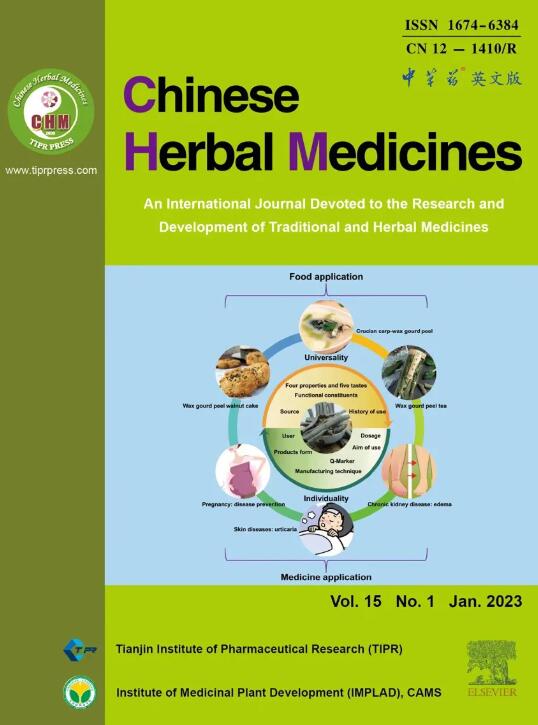板头沉香树干不同层真菌组成分析揭示沉香部位存在抑制曲霉的物质
IF 8.9
4区 医学
Q1 CHEMISTRY, MEDICINAL
引用次数: 0
摘要
目的分析板头沉香树干真菌组成,开发其应用潜力。方法sbt沉香是一种自然形成的沉香,采伐后采集。采用十六烷基三甲基溴化铵(CTAB)法提取BT沉香真菌的总基因组DNA,进行PCR扩增和文库构建。通过HiSeq2500平台获得有效标签,并对数据进行生物信息学和统计学分析。结果共检测到7 850 040个有效标签,其中子囊菌门含量最高,相对丰度为56.36% ~ 61.44%,担子菌门次之,相对丰度为10.49% ~ 20.39%。dothideomyetes、agaricomyetes和sordariomyetes在纲水平上占优势,分别占26.21% ~ 33.88%、8.40% ~ 17.66%和18.41% ~ 24.11%。属水平上以Lignosphaeria、Phaeoacremonium和Hermatomyces优势,相对丰度分别为6.25% ~ 7.64%、1.95% ~ 9.05%和1.5% ~ 5.4%。多样性和丰富度分析表明,沉香形成部位(沉香层、沉香上层和沉香下层)的真菌组成显著低于沉香分解层和健康层。也就是说,在沉香木形成过程中,真菌的多样性和丰富度在开放性伤口的作用下显著降低。沉香腐解层和沉香形成部位的真菌群落结构与健康层明显不同。沉香形成部位曲霉类群数量显著减少(健康层为0.5%,分解层为0.022%,上沉香层为0.012%,沉香层为0.01%,下沉香层为0.013%),说明沉香中可能含有抑制曲霉生长的潜在物质。结论沉香形成部位的沉香含有抑制曲霉的潜在物质,为防治沉香曲霉属提供了有价值的信息。本文章由计算机程序翻译,如有差异,请以英文原文为准。
Analysis of fungal composition in different layers of Bantou agarwood-forming trunk of Aquilaria sinensis revealing presence of Aspergillus-inhibiting substances in agarwood sites
Objective
The objective of this study was to analyse fungal composition and exploit application potential in the Bantou (BT) agarwood-forming trunk of Aquilaria sinensis.
Methods
BT agarwood is a naturally formed agarwood that was collected after cutting. Total genomic DNA of the fungi in BT agarwood was extracted by the hexadecyltrimethy ammonium bromide (CTAB) method, followed by PCR amplification and library construction. The effective tags were obtained by the HiSeq2500 platform, and the data were subjected to bioinformatics and statistical analyses.
Results
A total of 7 850 040 effective tags were obtained, Ascomycota was the most abundant fungus at the phylum level, with a relative abundance of 56.36%–61.44%, followed by Basidiomycota, with a relative abundance of 10.49%–20.39%. Dothideomycetes, Agaricomycetes and Sordariomycetes were dominant at the class level, accounting for 26.21%–33.88%, 8.40%–17.66%, and 18.41%–24.11%, respectively. Lignosphaeria, Phaeoacremonium and Hermatomyces were dominant at the genus level, with relative abundances of 6.25%–7.64%, 1.95%–9.05% and 1.5%–5.4%, respectively. Diversity and richness analysis showed that the fungal composition in the agarwood formation sites (agarwood layer, upper agarwood layer and lower agarwood layer) were significantly lower than those in the decomposing layer and the healthy layer. That is, the fungal diversity and richness were significantly reduced during agarwood formation by the action of open wounds. The fungal community structure in the decomposing layer and agarwood formation sites obviously differed from that in the healthy layer. The number of Aspergillus taxa in agarwood formation sites decreased significantly (healthy layer is 0.5%, decomposing layer is 0.022%, upper agarwood layer is 0.012%, agarwood layer is 0.01%, and lower agarwood layer is 0.013%), indicating that agarwood may contain potential substances to inhibit the growth of Aspergillus.
Conclusion
Agarwood from agarwood formation sites contains potential substances that inhibit Aspergillus, which provides valuable information for the control of the genus of Aspergillus.
求助全文
通过发布文献求助,成功后即可免费获取论文全文。
去求助
来源期刊

Chinese Herbal Medicines
CHEMISTRY, MEDICINAL-
CiteScore
4.40
自引率
5.30%
发文量
629
审稿时长
10 weeks
期刊介绍:
Chinese Herbal Medicines is intended to disseminate the latest developments and research progress in traditional and herbal medical sciences to researchers, practitioners, academics and administrators worldwide in the field of traditional and herbal medicines. The journal's international coverage ensures that research and progress from all regions of the world are widely included.
CHM is a core journal of Chinese science and technology. The journal entered into the ESCI database in 2017, and then was included in PMC, Scopus and other important international search systems. In 2019, CHM was successfully selected for the “China Science and Technology Journal Excellence Action Plan” project, which has markedly improved its international influence and industry popularity. CHM obtained the first impact factor of 3.8 in Journal Citation Reports (JCR) in 2023.
 求助内容:
求助内容: 应助结果提醒方式:
应助结果提醒方式:


